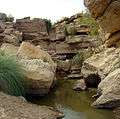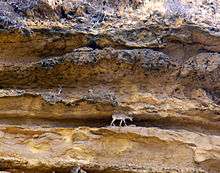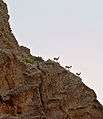Kirthar Mountains
Kirthar Mountains (Urdu: كوه کیر تھر) (Sindhi: کير ٿر جبل) or Arbiti Mountains (Arbita, Arbitani according to Ptolemy, named after a local tribe Arabitae) are a Mountain Range located in Balochistan and Sindh provinces of Pakistan. The Range extends southward for about 190 miles (300 km) from the Mula River in east-central Balochistan to Cape Monze (Muari), near Mubarak Village, Karachi on the Arabian Sea.

Kirthar National Park is one of the major wildlife reserves in Sindh, Pakistan. The Kirthar Range forms the boundary between the Lower Indus Plain (east) and southern Balochistan (west). It consists of a series of parallel rock hill ridges rising from 4,000 feet (1,200 m) in the south to nearly 8,000 feet (2,500 m) in the north.
The maximum elevation in the Sindh Segment of Kirthar Mountains was reported in April 2009, as 7,056 feet above sea-level. The discoverer of this peak, Syed Hasan Shahid Bukhari, named the elevation/peak, Koh Benazir, relying on Google Earth telemetry ... Koh Benazir is located in Barough branch of Kirthar mountains, off Dadu, and the discovery of this elevation makes Koh Benazir, the highest mountain peak of Sindh, situated a few miles north-west of the upcoming Gorakh Hill Station,a 5688 feet from sea level plateau in Kirthar mountain range.
The next highest Peak of Sindh is a 6880 feet high peak, known locally as Kutte-di-Kabar (Dog's Grave). There are also a number of other peaks in the Sindh segment of Kirthar Mountains exceeding 5,500 feet; these all receive occasional snowfall during the winter rains.
Kirthar has a simple mountain structure of the regular anticlinal type, with the arches steepest towards the north and the west and gently dipping towards the south and the valley of the Indus.
The inhabitants of the Kirthar Range are chiefly Brahui, Sindhi, and Baloch tribes, on both sides of the Kirthar Mountains. They subsist by flock grazing. Major Baloch tribes of Kirthar are Burfat, Gabol, Marri, Bozdar, Lund, Nohani, Rustamani, Bugti, Lashari, legari and others.
-

Cold water Spring in Kirthar National Park
-

Chinkara gazelles in Kirthar Mountains
-

-

-

-

-

-

-

-

-

-

Taung
See also
- Mountain ranges of Pakistan
- List of mountains in Pakistan
- List of mountain ranges of the world
- List of highest mountains of the world
- Bado Hill Station